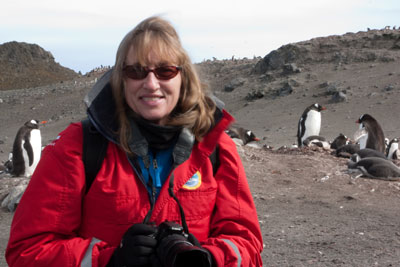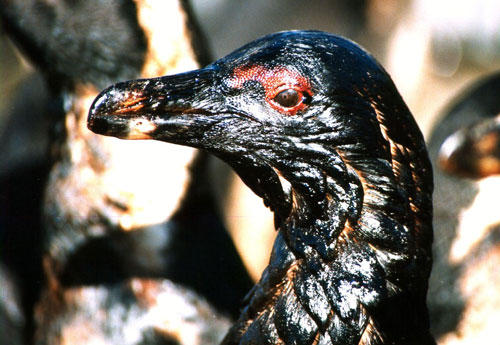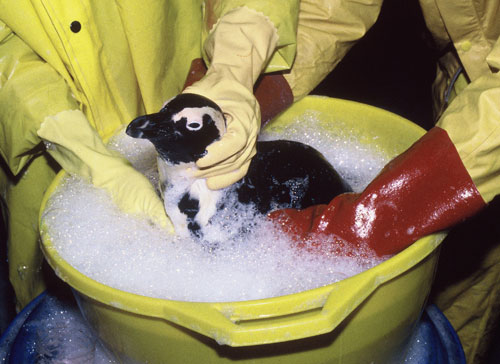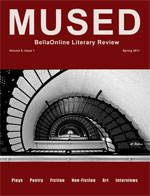Dyan deNapoli
Lisa Shea
Dyan deNapoli is a renowned expert in penguins. She recently wrote “The Great Penguin Rescue: 40,000 Penguins, a Devastating Oil Spill, and the Inspiring Story of the World's Largest Animal Rescue.” Dyan carved out time in her busy schedule to talk with us about the penguin rescue experience and the process of getting published.

How did you first get interested in penguins?
It actually began with a fascination with dolphins, thanks to the TV show Flipper and a visit to the Miami Seaquarium at the age of 5. I always dreamed of working with dolphins and, after postponing that dream until I was 32 years old, I returned to college to pursue a Bachelor's Degree in Animal Science. I chose this program because it would give me the prerequisite education to apply for an internship at the Kewalo Basin Marine Mammal Laboratory (KBMML), a dolphin facility in Hawaii. Part of the requirement for graduation was one year of full-time rotations at different animal facilities. I was selected for a four-month internship at the dolphin facility, which was magical - and the fulfillment of my lifelong dream. I was later accepted for a four-month rotation at Boston's New England Aquarium, where I worked daily with the penguins. From the moment I stepped foot into the penguin exhibit, I was hooked!
What happened to cause the disaster?
An iron-ore carrier - ironically named the MV Treasure - was traveling from Brazil to China when an enormous hole mysteriously appeared in the hull. It was never determined what caused the damage, but it might have been a cargo container that had been swept off of another carrier. These containers sometimes float just below the surface, making them invisible to passing ships. When the hole was discovered in the ship's hull, they were 700 miles offshore. The captain asked for permission to enter Table Bay, near Cape Town, to inspect the hull and conduct repairs. Different groups debated about where the ship should be repaired and where to unload the fuel oil, and the decision was finally made to tow the ship 50 miles offshore and conduct repairs there.
Unfortunately, while being towed out of the area, the tow line broke, and after drifting back towards shore, the ship sank in Table Bay on June 23, 2000. Within 12 hours, a 3-mile long oil slick had spread across Table Bay, threatening to oil the 75,000 penguins living and breeding on islands there.

How did the rescue group decide to call you in for help?
Estelle van der Merwe, center manager of the local seabird rescue center, SANCCOB (Southern African Foundation for the Conservation of Coastal Birds), immediately contacted professional animal rescue groups when the ship first sank. She knew from prior experience that an expeditious and organized response was critical if they were to conduct a successful rescue effort. She knew this because, exactly six years prior to the Treasure sinking, another iron-ore carrier, the Apollo Sea, foundered and spilled its fuel oil in Table Bay. When the Apollo Sea sank on June 20, 1994, it threatened the same population of African penguins breeding on Robben and Dassen Islands. Ultimately, 10,000 oil-covered penguins were rescued. It was the largest number of penguins that had ever been rescued at one time, and they just were not prepared to handle a response on such a large scale. Unfortunately, half of those oiled penguins perished.
Through the difficult lessons learned during that rescue, they were far better prepared to respond when the Treasure oil spill occurred - which was a good thing, because twice as many penguins were oiled in the Treasure spill, and four times as many were handled overall. The first two groups Estelle called in were the IBRRC (International Bird Rescue Research Center) and IFAW (International Fund for Animal Welfare), whom she had worked with during other rescues. The IBRRC managed the washing and rehabilitation of the penguins, and IFAW handled the logistics of the staff and volunteer response.
Shortly after these two groups arrived, and the true extent of the oil spill became evident, Estelle began calling in penguin experts from animal facilities worldwide. I was a member of the first team of zoo and aquarium professionals to arrive from the United States (there were eight of us on the team). Ultimately, approximately 110 penguin specialists flew to Cape Town in staggered shifts over the three-month course of the rescue to serve as rehabilitation supervisors. In addition, more than 12,500 volunteers (with absolutely no experience handling penguins) showed up at the rescue centers. Because of this incredible volunteer response, 95% of the penguins were saved!
What was the most challenging part of the rescue?
Part of it was the grueling physical aspect. It was the most bone-numbing exhaustion I have ever experienced. We were up at 6:00 am, at the rescue centers by 6:45 am, and didn't leave until 10:30 or 11:30 pm. During the day, we didn't eat, and rarely drank anything or used the bathroom - there was just too much work to be done. Our team worked like this for eighteen straight days, and I lost twelve pounds in that time. The work was incredibly intense, because there were 19,000 oiled penguins that had to be washed and rehabilitated - the massive room that I was running with my colleague from the New England Aquarium had 4,500 penguins in it! And given the fact that it was the largest number of animals ever to be rescued from an environmental disaster, the atmosphere was very tense, because we just did not know if we would have a successful outcome or not.
This led to another challenging aspect, which was the emotional and psychological impact of the animal rescue. Seeing thousands of oiled and shell-shocked penguins crammed into the rescue centers was disturbing and surreal - but we had to push down the painful emotions we were experiencing in order to soldier on and carry out the mammoth task at hand.

What made you decide to write a book about the experience?
I couldn't NOT write it. The idea of this book has been brewing ever since I returned from South Africa. I always knew I would write a book about the Treasure oil spill someday - but while I was working at the New England Aquarium, I just did not have the time or energy to devote to writing a book. It was only after I left my position as a Senior Penguin Aquarist and started my educational company, The Penguin Lady, that I found both the time and the energy to do so. I was also encouraged by my audiences - after nearly every presentation that I gave about the penguin rescue effort, people would come up to me afterwards and say, "That is such an amazing story! You have GOT to write a book about it!" Surprisingly, no one else had written a book about this historic event. My book was scheduled to be published near the 10-year anniversary of the Treasure oil spill - my only fear was that someone else would come out with a book about the rescue before I did!
My mission as The Penguin Lady is to raise funding and awareness to protect penguins, because these unique seabirds are in serious trouble. Fourteen of the eighteen penguin species are currently classified as Threatened or Endangered. As an indicator species, the precipitous decline of penguin populations throughout the southern hemisphere is a red flag signaling that the health of their ecosystem is compromised. My goal in writing the book was to spread awareness about the Treasure oil spill and our impact on the environment, and to raise funds for penguin rescue, research and conservation. To that end, I'm donating 20% of my proceeds from the book (and from every public appearance) to penguin organizations.
How long did it take you to write the book?
The entire process - including writing the proposal and working on edits after the manuscript was delivered - was about two and a half years. The bulk of the manuscript was written during a very focused six-month period. During that time, and during the six months after my manuscript was submitted, I literally did not take one day off from writing and editing. And those were all 8-12 hour days - often longer. As each deadline approached, I found myself pulling more all-nighters than I did during my entire college career! I stayed up for three days straight to meet my original manuscript submission deadline. I don't recommend it.

What was the biggest challenge in writing the book?
See above! The lack of sleep, the lack of free time, the lack of any semblance of a social life - including spending time with my long-suffering partner, Marc. I now know why every author thanks their spouse or partner for putting up with their protracted absence while they wrote their book. But if you're not writing under contract, as I was, you can write at your leisure. Having a deadline that must be met creates a great deal of pressure. But for those needing external motivation, those deadlines can certainly can help you meet your writing goals!
What was the publisher-finding process like?
My rockin' agent, Julie Barer, took care of that part. Once I signed with her, we did a little more tweaking of my proposal before she submitted it to editors at the various publishing houses. She had me expand my chapter summaries from 35 pages to 55 pages, so that the chapter summary section read more like a Cliffnotes version of the book. Before submitting my proposal, she spent a lot of time telling different editors about it in person to get them excited about it. Then, on October 16, 2008, she submitted my proposal to about 20 editors at various houses. When I asked her how long it might be before we heard anything back, she said it can take weeks or even months to get a response. So when she called the next day to tell me we had a pre-empt offer from Simon & Schuster's Free Press imprint, I was floored.
(A pre-empt offer is a very high offer that a house comes back with right away, in hopes that you'll jump at it. It can be tricky, because you run the risk of a) declining their offer, then not getting as high of an offer when your book goes to auction or b) accepting their offer, but losing out on a potentially higher offer if your book had gone to auction between all of the houses. Of course, you'll never know how high it might have gone. So, accepting a pre-empt offer is obviously a gamble.)
Julie then let the rest of the editors know we had a pre-empt offer, and asked if anyone else wanted to match it. Many houses just can't make the decision that quickly, as the editor has to first sell the idea of the book to a whole slew of people at their house - their boss, their sales team, their marketing team, etc. So, after one other house came back with a pre-empt offer that day, Julie thought we should take the book off the table and have an auction between the two houses who had offered a pre-empt (instead of going to auction later with all 20 houses).
After two more days of back and forth, I ultimately accepted an offer from Free Press that was more than three times the original pre-empt offer. I went with them for two reasons: first, there were rumblings of an upcoming merger at the house I didn't go with, and things can get very messy with mergers. And, second, when I told both houses that I wanted the book to be produced in a way that was as environmentally friendly as possible, Free Press impressed me with an extremely thorough 'green' publishing plan. (And it probably helped tip the balance just a bit when my future editor at Free Press told me she had cried openly on the subway while reading my book proposal!)
Were there any parts of the book writing process which you had not expected?
Oh my goodness, yes! I'm a rabid researcher, but there were many details that I had never read about or heard about before. Many aspects of getting a book published remain shrouded in mystery, and nobody tells you how exactly to navigate this industry. It's definitely trial by fire - and there's a steep learning curve. Just a few examples would be the following: Once you've submitted your manuscript, there are several more months of editing and copyediting rounds. I had no experience with copyediting, so when my copyedited manuscript was delivered to my house and I opened the package, I was confronted with 320 pages of paper covered with red symbols that looked like a cross between shorthand and hieroglyphics. So, before I could approve their copyedits, or make any of my own, I had to figure out what each of those little red marks on each page meant.
Another example was learning how much of the publicity and promotion would be on my shoulders. This is not to say the house doesn't do anything - it certainly does a lot. They have contacts with hundreds of media outlets that I would never have access to, and my publicist at Free Press sent out 350 copies of my book to those different outlets, which led to several radio, television, magazine, newspaper and blog interviews and reviews. However, I had assumed the house would also put on the launch party for the book. Um...no. When I asked what the plan was for the launch party, they informed me that, due to financial restraints, they don't throw launch parties for most of their authors any more. So, I threw my own launch party. Which was fabulous, by the way! It was a book launch, as well as a fundraiser for penguins - we had a silent auction of photographs that Marc and I had taken in Antarctica, and we raised $1,750 for penguin rescue groups!
How much time do you spend in marketing activities, now that the hardcover is out?
A lot! However, I've been busy with copyedits, etc. for the paperback, so this has been on the back burner for a bit. But, in speaking with other authors, I've learned that this is a process that never stops. And no matter who you've published with (large house, small house, self-published) the onus is on YOU to market the heck out of your book. Unless you're Steven King or John Grisham or Anita Shreeve or some other author that's a household name, do not expect the house to spend their whole budget promoting little old you. Even the large houses are feeling the pinch in this financial climate, and they just don't have the resources to be able to aggressively promote all of their authors - so the bulk of their marketing dollars are spent on their bestselling authors (which is ironic, because those books pretty much sell themselves anyway). As literary agent Sorche Fairbank has said (and I'm now quoting author Randy Susan Meyers, who quoted Sorche), “No one will care about your book as much as you do. No one.” So, once you have finished writing and editing and copyediting your book, your new full-time job is promoting it.
What additional work is involved in putting out the paperback version?
I've JUST submitted my copy edits for the paperback version of The Great Penguin Rescue. This was to make minor changes or corrections of things that were missed in the hardcover. I'll also be reviewing the copy they come up with for the back cover - and I'll have input into the quotes from reviews that will be included in the paperback. And, though there hasn't been talk about it yet, it's always possible the house will want to change the cover design in some way. Stay tuned.... And then there's the publicity/promotion campaign for the paperback. This will entail several calls and e-mails with my publicist at Simon & Schuster, as well as with my agent, to discuss the publicity plan. And I will try to do more internet publicity as well. This will include keeping the 'events' page on my website and my blog updated, as well as keeping the book tour pages on Goodreads.com and Booktour.com updated. I may do a blog book tour as well. And perhaps buy advertising on Facebook, as an author friend recently suggested. And I will continue to educate myself about the process by reading as many books as I can about it.
What advice do you have for an aspiring author who wants to get published?
Get thee to writer's conferences posthaste! This was probably the most important thing I did that helped me get published - because it was at a writer's conference that I met my agent. If you want to get published by one of the major houses, it is absolutely essential that you are represented by an agent. (Unless, by some crazy miracle, you're one of those incredibly rare writers who somehow manages to get picked up on your own - but don't count on that happening. Really. Don't.) Most editors at publishing houses will not even glance at a proposal or a manuscript unless it's already gone through the vetting process by a reputable literary agent. Editors rely on agents to do the monotonous work of plowing through thousands of proposals to weed out the chaff and present them with only the finest, most saleable work.
In lieu of that, write the best damn query letter you possibly can. You should study successful query letters and spend a LONG time working on this, because you only get one chance to make a first impression, so it had better shine. You're a writer after all - so do your most rigorous editing on your query letter. But, if at all possible, get to those conferences, because I believe that pitching agents face-to-face gives you a tremendous advantage over people trying to get the attention of an agent via a query letter. When meeting you in person, the agent can see and feel and hear your excitement. And I believe that, in turn, gets them much more excited about you and your book. (I pitched six agents at two conferences, all of whom asked to see my proposal, and four of whom later offered representation. I highly doubt I would have had those same odds had I pitched them by letter.)
Of course, it's critical that you hone and practice the heck out of your 30-second pitch. That's right...30 seconds. One minute, MAX. If you can't crystalize what your book is about in approximately 30 seconds, then you don't really know the essence of your own book and you will quickly lose an agent or editor's interest. Craft your pitch, then practice it out loud. Over, and over and over until it slides off your tongue like butter.
We thank Dyan again for her helpful information! Dyan’s book, “The Great Penguin Rescue”, can be found at Amazon and most other book stores!
Lisa Shea
BellaOnline.com

